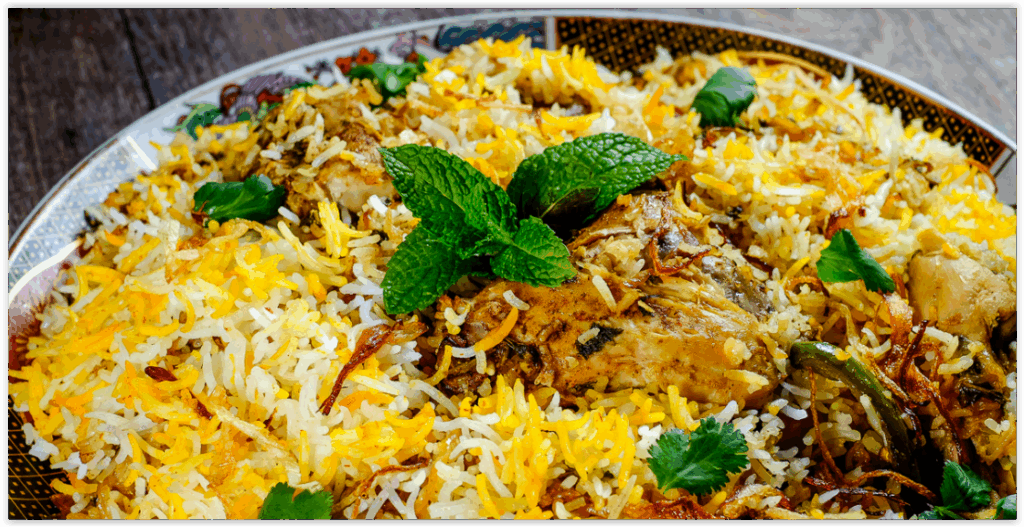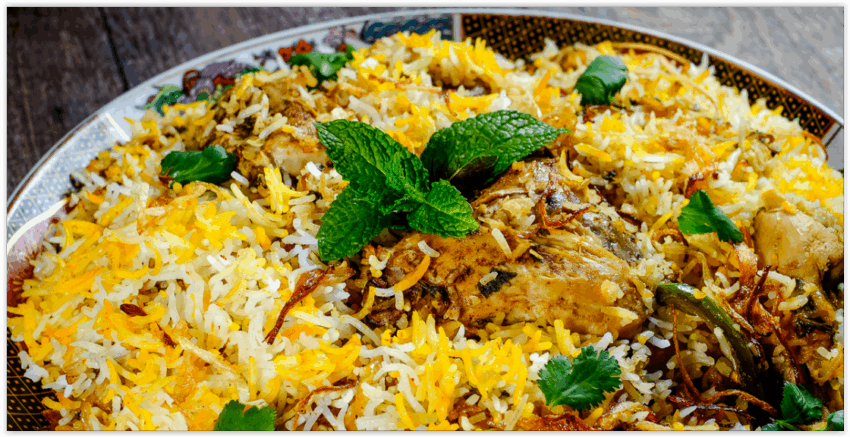
Is Biryani Healthy? A Deep Dive into its Nutritional Profile
Biryani, a beloved dish across South Asia and beyond, is a fragrant and flavorful rice preparation often associated with celebrations and special occasions. But amidst its rich taste and cultural significance, a crucial question arises: is biryani healthy? This comprehensive guide will delve deep into the nutritional aspects of biryani, examining its ingredients, preparation methods, potential health benefits, and drawbacks. We aim to provide a balanced and expert perspective, empowering you to make informed choices about incorporating this popular dish into your diet. We understand the conflicting information available, and we are here to offer clarity based on nutritional science and culinary understanding. This isn’t just another article; it’s your go-to resource for understanding the health implications of enjoying biryani.
Understanding Biryani: Ingredients, Preparation, and Variations
To accurately assess whether is biryani healthy, it’s essential to understand its core components and the variations that exist. Biryani is fundamentally a mixed rice dish, typically made with basmati rice, meat (chicken, mutton, beef, or fish), vegetables, spices, and aromatic herbs.
Core Ingredients: A Closer Look
- Basmati Rice: A long-grain rice known for its aroma and fluffy texture. It’s a source of carbohydrates but has a relatively high glycemic index.
- Meat/Protein: Chicken, mutton, beef, fish, or eggs provide protein and essential nutrients. The choice of protein significantly impacts the overall fat content.
- Vegetables: Onions, tomatoes, potatoes, and other vegetables add fiber, vitamins, and minerals. The variety and quantity of vegetables can enhance the nutritional value.
- Spices and Herbs: A complex blend of spices like cumin, coriander, turmeric, ginger, garlic, cardamom, cloves, and saffron contribute to the flavor profile and may offer antioxidant benefits.
- Ghee/Oil: Used for cooking and flavoring, ghee (clarified butter) or vegetable oil contributes to the dish’s fat content.
Preparation Methods: Impact on Health
The method of preparation significantly influences the healthiness of biryani. Traditional methods often involve frying ingredients in ghee or oil, increasing the fat content. Modern adaptations may use healthier cooking techniques like steaming or baking.
Regional Variations: A World of Flavors (and Nutritional Differences)
Biryani varies significantly across regions, each with its unique ingredients and preparation styles. Hyderabadi biryani, for example, is known for its rich flavors and use of meat, while Lucknowi biryani is lighter and more aromatic. These variations impact the nutritional composition.
Nutritional Breakdown: What’s Inside a Serving of Biryani?
Determining if is biryani healthy requires a detailed look at its nutritional content. The following is an approximate nutritional breakdown for a typical serving (around 300-400 grams) of chicken biryani. These values can vary based on the recipe and portion size.
- Calories: 400-600 kcal
- Protein: 20-30g
- Carbohydrates: 50-70g
- Fat: 15-30g (depending on the amount of ghee/oil used)
- Fiber: 3-5g
- Vitamins and Minerals: Varies based on the vegetables and spices used; can include Vitamin A, Vitamin C, iron, calcium, and potassium.
It’s important to note that these are estimates. A mutton biryani, for instance, will likely have a higher fat content than a chicken or vegetable biryani.
The Good: Potential Health Benefits of Biryani
Despite concerns about its calorie and fat content, biryani can offer some health benefits, particularly when prepared with a focus on healthier ingredients and methods. So, is biryani healthy in some aspects? Yes, it can be.
Protein Powerhouse
Biryani is a good source of protein, essential for building and repairing tissues, supporting immune function, and promoting satiety.
Rich in Antioxidants
The spices used in biryani, such as turmeric, ginger, and garlic, are rich in antioxidants, which help protect the body against damage from free radicals. Turmeric, in particular, contains curcumin, a compound with potent anti-inflammatory properties.
Source of Fiber
The vegetables included in biryani contribute to its fiber content, promoting digestive health, regulating blood sugar levels, and aiding in weight management.
Versatile and Customizable
Biryani can be easily customized to suit dietary preferences and health needs. You can opt for lean protein sources, increase the amount of vegetables, and use healthier cooking methods.
The Bad: Potential Health Drawbacks of Biryani
While biryani offers some benefits, it’s crucial to acknowledge its potential drawbacks, especially when consumed in large quantities or prepared with unhealthy methods. Therefore, consider if is biryani healthy overall, or just in parts?
High in Calories
Biryani can be calorie-dense, contributing to weight gain if consumed frequently and in large portions. This is particularly true for biryani prepared with generous amounts of ghee or oil.
High in Fat
The fat content of biryani can be significant, especially when made with fatty meats or cooked in ghee. High fat intake can increase the risk of heart disease and other health problems.
High Glycemic Index
Basmati rice, a staple ingredient in biryani, has a relatively high glycemic index, meaning it can cause a rapid spike in blood sugar levels. This can be problematic for individuals with diabetes or insulin resistance.
Sodium Content
Some biryani recipes may contain high levels of sodium, which can contribute to high blood pressure and other health issues.
Making Biryani Healthier: Tips and Tricks
The good news is that you can enjoy biryani without compromising your health. By making a few simple changes to the ingredients and preparation methods, you can significantly reduce its calorie and fat content while maximizing its nutritional value. So, the answer to “is biryani healthy” can be “yes,” with modifications.
Choose Lean Protein Sources
Opt for chicken breast, fish, or lean cuts of mutton instead of fatty meats. You can also use plant-based protein sources like lentils or chickpeas.
Increase Vegetable Content
Add more vegetables like carrots, peas, beans, and bell peppers to increase the fiber and nutrient content.
Use Healthier Cooking Methods
Instead of frying ingredients in ghee or oil, try steaming, baking, or using an air fryer. You can also use a minimal amount of healthy oils like olive oil or avocado oil.
Control Portion Sizes
Be mindful of your portion sizes. A moderate serving of biryani (around 300-400 grams) is usually sufficient.
Use Brown Rice
Consider using brown rice instead of white rice. Brown rice has a lower glycemic index and is a good source of fiber.
Reduce Sodium Content
Use fresh herbs and spices instead of salt to flavor your biryani. You can also use low-sodium soy sauce or broth.
Expert Review: A Balanced Assessment of Biryani’s Health Impact
As a culinary expert with years of experience in South Asian cuisine, I’ve had the opportunity to analyze and prepare countless variations of biryani. Based on my observations and understanding of nutritional principles, I offer the following balanced assessment. Is biryani healthy in its traditional form? Not always. But can it be a part of a healthy diet? Absolutely.
User Experience & Usability: A Culinary Perspective
From a culinary standpoint, biryani is a complex dish that requires skill and attention to detail. The balance of flavors, the texture of the rice, and the tenderness of the meat are all crucial elements. When prepared correctly, biryani is a truly satisfying and enjoyable culinary experience.
Performance & Effectiveness: Delivering on Flavor and Satisfaction
Biryani’s primary purpose is to deliver a flavorful and satisfying meal. When made with high-quality ingredients and cooked with care, it undoubtedly achieves this goal. However, its effectiveness as a healthy meal depends on the choices made during preparation.
Pros: The Advantages of Enjoying Biryani
- Flavorful and Satisfying: Biryani offers a unique and complex flavor profile that is highly enjoyable.
- Good Source of Protein: Provides essential protein for various bodily functions.
- Versatile and Customizable: Can be adapted to suit different dietary needs and preferences.
- Rich in Antioxidants: Spices contribute to antioxidant intake.
- Culturally Significant: Offers a connection to South Asian culinary traditions.
Cons/Limitations: The Potential Drawbacks
- High in Calories: Can contribute to weight gain if consumed in excess.
- High in Fat: May increase the risk of heart disease.
- High Glycemic Index: Can cause blood sugar spikes.
- Sodium Content: Some recipes may contain high levels of sodium.
Ideal User Profile: Who Can Enjoy Biryani Responsibly?
Biryani can be enjoyed by most people as part of a balanced diet. However, individuals with diabetes, heart disease, or weight management goals should be particularly mindful of portion sizes and preparation methods.
Key Alternatives: Exploring Other Rice Dishes
Alternatives to biryani include pulao (a simpler rice dish with fewer spices), khichdi (a lentil and rice porridge), and stir-fried rice with vegetables and lean protein.
Expert Overall Verdict & Recommendation
Biryani is a delicious and culturally significant dish that can be enjoyed as part of a healthy diet when prepared and consumed responsibly. By making informed choices about ingredients, cooking methods, and portion sizes, you can minimize its potential drawbacks and maximize its nutritional benefits.
Insightful Q&A: Addressing Your Biryani-Related Questions
Q1: Can I eat biryani if I have diabetes?
A: Yes, but in moderation and with careful consideration. Choose brown rice biryani, control portion sizes, and pair it with fiber-rich vegetables to help regulate blood sugar levels. Monitor your blood glucose levels after eating.
Q2: Is vegetable biryani healthier than chicken biryani?
A: Generally, yes. Vegetable biryani tends to be lower in fat and calories compared to chicken biryani, especially if prepared with minimal oil. However, the nutritional value depends on the specific ingredients used.
Q3: How can I reduce the fat content in biryani?
A: Use lean protein sources, minimize the use of ghee or oil, opt for healthier cooking methods like steaming or baking, and trim any visible fat from the meat.
Q4: Is it okay to eat biryani every day?
A: Eating biryani every day is not recommended due to its high calorie and carbohydrate content. It’s best to enjoy it as an occasional treat rather than a daily staple.
Q5: What are the best vegetables to add to biryani for maximum nutritional value?
A: Opt for nutrient-rich vegetables like carrots, peas, beans, bell peppers, and spinach. These vegetables provide fiber, vitamins, and minerals.
Q6: Can I use quinoa instead of rice in biryani?
A: Yes, quinoa is a healthier alternative to rice. It’s a complete protein source and has a lower glycemic index.
Q7: How does the cooking method impact the healthiness of biryani?
A: Cooking methods like steaming, baking, or air frying are healthier than frying in ghee or oil, as they reduce the fat content.
Q8: What spices are most beneficial in biryani?
A: Spices like turmeric, ginger, garlic, cumin, and coriander are beneficial due to their antioxidant and anti-inflammatory properties.
Q9: How can I make biryani more filling without adding more calories?
A: Add more vegetables and protein to increase the fiber and protein content, which promotes satiety.
Q10: Is there a difference between Hyderabadi and Lucknowi biryani in terms of health?
A: Yes, Hyderabadi biryani tends to be richer and higher in fat compared to Lucknowi biryani, which is lighter and more aromatic. Lucknowi biryani is generally considered a slightly healthier option.
Conclusion: Enjoying Biryani Responsibly
In conclusion, the question of whether is biryani healthy is multifaceted. While biryani can offer certain nutritional benefits, its high calorie and fat content warrant careful consideration. By making informed choices about ingredients, preparation methods, and portion sizes, you can enjoy this beloved dish as part of a balanced and healthy lifestyle. Remember to prioritize lean protein sources, increase vegetable content, use healthier cooking methods, and control portion sizes. Share your experiences with healthy biryani variations in the comments below!

